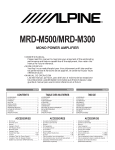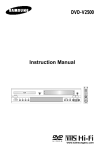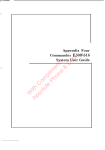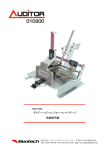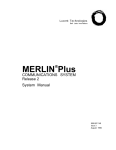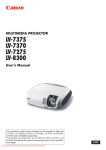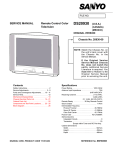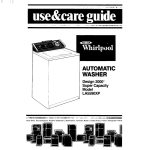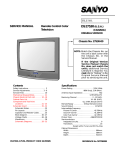Download Comdial ExecuTech 2000 LCD User Guide
Transcript
COMDIAL ExecuTech System 2000 Categories. . . Answering Calls ................. Making Calls ................... Holding Calls ................... Transferring Outside Calls ......... Conferencing ................... Messaging ..................... Programming ................... Miscellaneous Features ........... Speakerphone Operation .......... Feature Dialing Code Numbering Call Indicators .................. Glossary Of Terms ............... Speed Dial index ................ Subcategories.. Answering Outside Calls ..... Answering Intercom Calls .... Call Pickup - Direct. ......... Call Pickup - Group ......... Trunk Answer From Any Station Handsfree Answerback (HFAB) Outside Line Calling ......... Trunk Group Access. ........ Intercom Calling ............ Intercom Voice Calling ....... Intercom Tone Calling ....... Off-Hook Voice Announce Speed Dialing ........... Automatic Dialing ........ Automatic Redialing ...... Last Number Redial ...... Saved Number Redial .... Extended DTMF ......... Manual Hold ............... Exclusive Hold ............. Hold Recall Feature ......... Direct Station Hold .......... Call Park ................. Screened Transfer .......... Unscreened Transfer ........ Multiline Conference ........ Add-on Conference ......... .. .. .. .. . .. .. .. .. .. . . .. . .. . . . .. . .. . .. Plan .. . . .. . . . , .. .. .. .. 1 5 .13 .15 .17 .19 .23 .31 .41 .42 .43 .51 .56 . . . .. . .. . .. .. . . .. . .. .. . . .. .. . . . . . . . .. . . . .. .. .. . . .. . . . . . .. . . . . .. . . . . . . . 1 . .1 . 2 2 3 . 3 . .5 . .6 . 7 7 . 8 . 9 .lO .lO .ll .ll .12 .12 .13 .13 .13 .14 .14 .15 .16 .17 .17 ii .................................. Three Party Internal Conference Message Waiting Control ........................................ LCDMessaging .............................................. Station-To-Station Messaging .................................... Autodial Programming .......................................... Station Speed Dial Programming .................................. Direct Station Selection/Busy Lamp Field (DSS/BLF) Programming Programming Automatic Redial ................................... Programming Secure Off-Hook Voice Announce ...................... Personal Ringing Tones ......................................... VoiceAnnounceBlocking.........................................3 Line Monitoring ............................................... Recall/flash ................................................. Flash ...................................................... Recall........................................................3 Paging ..................................................... External Paging ............................................... All-call And Zone Paging ........................................ Meet-MePage ............................................... Do Not Disturb ................................................ Mute I Handsfree Answer Inhibit .................................. CalfWaiting ................................................. Call Forwarding .............................................. Call Forwarding - Personal ....................................... Call Forwarding -All ........................................... Pulse/tone Switching ........................................... BackgroundMusic ............................................ Automatic Call-Back. ...................................... Ringer Volume Control .......................................... Display Intensity Adjustment ............................ Speakerphone Operation ........................................ .., 111 ....... .18 .18 ..2 0 .21 .23 .26 .29 .30 -30 .31 1 .32 ..3 2 ..3 2 2 ..3 3 .33 -33 ..3 4 -35 -35 ..3 6 ..3 7 .37 , .... , ........ , .38 .38 ..3 9 -39 .40 40 .41 Outside Calls . . . Calls appear at keys that have actual line assignments. l Press line key of ringing line (line key with flashing light) . Display: l Lift handset. NOTE: If a prime line is assigned and is ringing, or if the telephone can answer any ringing line (ringing line preference enabled), do not press the line key of the ringing line. Intercom Calls . . . To answer a voice call, Display: l Speak toward the telephone. l Lift handset if privacy is desired. NOTE: Voice calling can be blocked. See the discussion Voice Announce Blocking for details. To answer a tone call, * Lift handset to talk. titled, Call Pickup . . . DIRECT To answer a call that is ringing at another telephone, l Lift handset. . Press @ . l Dial (-x., @ l Dial extension number of ringing telephone. . Display: GROUP To answer a call that is ringing within your group, l Lift handset. . Press @. Display: l 2 Talk. Trunk Answer From Any Station. . . When the attendant station has enabled the night transfer (of ringing) feature (denoted by a flashing ITCM light at stations 10 and 12), an outside call can be answered from any station in the system. Hear ringing (loud ringer, night transfer station, etc.). l l Press l Dial @ 0 KM . (@. Display: l Answer call. Handsfree Answerback (HFAB) . . . While a station is busy on a call, an off-hook voice announcement may be received either as a non-secure off-hook voice announcement (OHVA) or as a secure off-hook voice announcement (SOHVA). An OHVA announcement is sounded through the speaker of a paired console or the station on certain model multiline keysets. A SOHVA announcement is only sounded through the handset receiver of certain model multiline keysets. To respond to an OHVA announcement, l l Hear alerting tone (five quick tone bursts) and announcement sounded from console speaker. Speak toward microphone reply. NOTE: opening in console to While the distant party cannot be prevented from hearing the announcement, the user can press and hold MUTE key to prevent distant party from hearing the response. Continued on next page . . . 3 Handsfree Ans werback (HFA B) (continued) . . . To respond to a SOHVA announcement, l l l Hear tone alert and announcement receiver. Distant party cannot nouncement. Resoond in a verbal manner: Press and hold @ and reply by speaking into handset transmitter. Distant party cannot hear response. spond In a non-verbal manner; Press preprogrammed softkey to cause a set message to appear in display of a announcing station (if it is an LCD speakerphone). This action also disconnects the announcing station. c 4 in handset hear an- Outside Line . . . LINE KEY SELECT l Press line key to select line. Display: NOTE: Selecting l a line is not necessary if: A priority line has been assigned line feature enabled), to a telephone (prime The telephone automatically picks an idle line for use when the handset is lifted (id/e line preference feature enabled). 4 Listen for dial tone. l Dial number. When party answers, l Lift handset. To end call, l Hang up handset. Continued on next page. . 5 Outside Line (continued) . . . TRUNK GROUP ACCESS If the system provides trunk groups, 0tTCM . l Press l Dial trunk group access code LINE TYPE 9 = main trunk group 81 = secondary trunk group 1 82 = secondary trunk group 2 83 = secondary trunk group 3 l Listen for dial tone. l Dial number. TRUNK GROUP QUEUING A station can be placed in a queue to await the availability of a trunk group if all trunks in the group are busy. 0tTcM l Press l Dial trunk group access code (9,81,82,83). l Hear busy tone. l l . Dial (SC7 @ and hang up. When trunk group is free, station will ring. Lift handset, hear trunk dial tone, and place call. To cancel queuing, l Press l Dial a 0fTCM . @ , and hang up. i. i. :.’ 6 Intercom . . . Intercom calls may be manually dialed or they may be automatically dialed using a pre-programmed Direct Station Selection (DSS) key. VOICE 1.I CALLING To voice call an intercom station, l Lift handset. l Press l 0tTCM . Dial extension dial (@ .) number. (To call system operator, Display: l Speak to called party. To voice call a DSS number, l l l Lift handset. Press softkey that is programmed tion. for desired sta- Speak to called party. NOTE: The outside line is automatically placed on hold when a DSS key is pressed or when the lTCM key is pressed prior to manualb dialing an intercom extension number. :~ Continued on next page . . . 7 Intercom (continued) . . . TONE CALLING To tone call an intercom station, l Lift handset. l Press l Dial extension number. 0U-CM , Display: l Press NOTE: 0 lTCM again. Called telephone will ring. Some systems may be programmed to tone signal as the first option. Pressing /TCM a second time is not necessary in this case. To tone call a DSS number, l l l Lift handset. Press softkey that has been pre-programmed desired station. 0 Press KM When intercom party answers, twoway conversation can take place. NOTE: 8 for The lights (LEDs) adjacent to softkeys indicate status of DSS telephones: DARK indicates idle telephone. STEADY-ON indicates telephone in use. FLASHING indicates station is ringing. Off-Hook Voice Announce. To make a voice announcement or busy on a call, l l .. to another station that is off-hook Make intercom call. Hear OHVA warning tone (five quick tone bursts), and make announcement. (If busy tone is heard, announcement cannot be made.) o Wait on line for reply. If announcing from an LCD speakerphone, called station may send non-verbal reply for display. As non-verbal message is displayed, station is disconnected. NOTE: The announcement may be received as an off-hook voice announcement (OHVA) or as a secure off-hook voice announcement (SOHVA). The method in which the announcement is received is not controlled by the caller. Rather, it is dependent upon the type of equipment being used at the called station and class of service programming. A multiline telephone and DB32S-xx console combination can receive an OHVA announcement but cannot receive a SOHVA one. Certain multiline telephones are equipped to receive announcements in a SOHVA mannerwithout need of the companion console. If this telephone is being operated with the handset lifted, the announcement will be received in an SOHVA manner. If it is being operated in a handsfree manner, the announcement will not be received. 9 Speed Dialing. . . To dial station speed dial numbers, Reference Speed Dial Index Card. l Dial a keypad digit (0 through sonal speed dial number. l 9) for desired per- ma If on line listening to dial tone, 0 = Press HOLD . Dial a desired keypad digit (0 through l To dial system speed dial numbers, l Reference System Speed Dial List. l Press 0* . Dial the memory location digits (01 through desired system speed dial number. l 9 ). 99) for uzl If on line listening to dial tone, l l 0HOLD . Press Dial a through plus the memory location digits (01 99) for desired system speed dial numbers. Automatic Dialing . . . To automatically l dial numbers, Press pre-programmed ber. If desired softkey is programmed key), l 10 Press 0HOLD softkey for desired numon second level (under DSS and then press desired softkey. Automatic Redialing . . . To actlvate automatic redial, Press softkey pre-programmed l for that purpose Number will be dialed once a minute minutes. l :’ for ten If call is answered, Take control by lifting handset. l If called station is busy, II Press auto redial softkey to begin redial cycle immediately. (Auto redial LED lights.) l To cancel automatic redial, Press auto redial key, lift and replace handset, or press any station key. (Auto Redial light goes out.) l NOTE: Any user originated station activity during automatic redial will cancel the feature. Last Number Redial . . . The last number previously dialed can be automatically with a one or two-key action. l l Press a. press 0HOLD ( If on line listening to dial tone, then press El 4 Listen for ringing or busy tone. l l redialed Ringing tone: When party answers, pick up handset. Busy tone: Press @ to disconnect. Display shows last line used and number dialed. Continued on next page . . . 11 Saved Number Redial. . . The first 16 digits of the last manually dialed number can be saved for later redial. To save the number, l Press softkey pre-programmed for this purpose. To dial a saved number, l Lift handset. Listen for dial tone. l Press HOLD then press pre-programmed 0 softkey. Extended Dual Tone Multiple Frequency (DTMF) The length of the DTMF tone can be extended from the standard length to a pre-programmed longer length for accessing answering machines, banking computers, etc. that require DTMF tones longer than 80 msec. in length. To extend tone length, l Take station off-hook (lift handset or press 0 SPKR l l l ). Press line key if line is not automatically Wait 10 seconds, and dial number. generate long DTMF dial tones. selected. System will ma Immediately press HOLD then press line key to set system to generate long DTMF dial tones. 0 To alternate between long tone and standard tone length during a call, l 12 Press 0HOLD then press line key. Manual Hold. , . j: .. : .. ::. To place call on hold while on line, l Press 0HOLD . Exclusive Hold . . . (Only your telephone can retrieve held call.) l Press 0HOLD twice. To retrieve held call, l Press line key with flashing light. l m Press 0HOLD pearance. if station does not have line ap- Hold Recall Feature . . . After a preprogrammed length of time, a call placed on hold will automatically ring back to the telephone which placed it on hold. If the call is on exclusive hold, it will revert to manual hold after the hold recall time period. The call can then be retrieved by anyone with that line appearance. 13 Direct Station Hold. . . To place a call on direct hold (park a call to a station), l l l While on line, press hold). Dial a @ to receive park. plus extension number a held call, From the hold receivin dial m @ d To cancel l (@ (outside call placed on If parked line appears on park receiving station, line flashes at normal hold rate. To retrieve l 0fTcM extension, . a held call from station which placed call on hold, Dial (Jc7 @ holding station. plus extension number of the Cal/ Park. . . To park a call in one of nine orbits, l While on line, press @ l Dial a. l Dial a park zone access code (91 through To retrieve 14 a parked call, 0IToM l From any station, press l Dial a l Dial the park zone access code (91 through NOTE: 99). . . 99). If your telephone has direct call park zone appearances, simply press the desired zone button and the line automatically parks. The park lamp illuminates indicating park condition. Press the same park button to retrieve. Parked calls can also be retrieved as mentioned above. Screened Transfer. . . To conduct system, a screened transfer to another station in the Answer outside call. (Do not press hold.) Press @@ ically.) . (Call is placed on hold automat- Dial extension number of party to be transfered to (or press DSS key for one-key intercom calling). Display: When intercom party answers, announce call. Press 0TAP . Hang up handset. If the called party is busy or does not answer, l Press @ to retrieve call. i. ,:1.; Unscreened Transfer. . , To transfer a call unscreened to another station in the system, l l l l Answer outside call. (Do not press hold.) Press @E$ ically.) . (Call is placed on hold automat- Dial extension number of party to be transfered to (or press DSS key for one-key intercom calling). Hang up handset. NOTE: If transferred line call is not answered afterpredetermined number of rings, call will ring at originating telephone. To answer recall of transferred call, l Press @. I:-: !~,.::-.: I ‘- 16 Multiline Conference . . . (2 external parties, 1 internal party) To set up a multiline conference, l l l Establish first outside call. (Do not press hold.) Press @. matically.) (Outside call is placed on hold auto- Establish second outside call. (Do not press hold.) 0 Press @. Conference is established. To remain active in conference with one conferee, l Stay on line when one party hangs up. To drop out of established conference, l Dial a and hang up. Add-On Conference . . . (1 external party 2 in ternai parties) l l Establish outside call. (Do not press hold.) Press a %Z .(Outside call placed on hold automatically). l Dial extension number of intercom party. l Wait for answer (announce conference l Press @ lished). . (A three-way connection intention). is estab. .. NOTE: Second internal station must either lift handset orpress intercom to acknowledge conversation. Otherwise conference will not work. ,, _’ ::. ,. ._.. 17 Three Party Internal Conference . . . II To set up a three party internal conference, * l . l Establish first internal call. (Do not press hold.) Press @g matically.) .( Internal call placed on hold auto- l Establish second internal call. (Do not press hold.) l Press a %: . Conference is established. To drop one conferee and remain active in conference other conferee, l Stay on line when one party hangs up. NOTE: 18 with Conference transmission levels are not compensated and are dependent upon the quality of the external lines. Message Waiting Control. , . The message waiting light at any telephone can be turned on by the central message desk (usually the attendant station) to alert the telephone user that a message awaits pick up. To turn on MW light, . Press @. l Dial (w) l @ . Dial extension number of station to be alerted. (The MW light of called station will flash.) To turn off MW light, 0tTCM . l Press l Dial @) l @) . Dial extension number of station that was alerted. (The MW light of called station will turn off.) To turn off MW light while delivering l Press 0 message, tTCM . To retrieve message at an alerted station, o Observe display. Display: XXXX = Name of party that left message. l Lift handset. . Press @ l Connection @ . to message desk is automatic. 19 .i, ,II LCD MESSAGING System supplied messages can be set at a station to be displayed on a calling LCD speakerphone. These messages will identify the current location of the normal telephone user and the expected return time. To turn on message, Press l 0ITCM . Display: l l Reference the message list. Dial the desired message code number (0 through 9). NOTE: The default messages be provided for use: l of “BACK AT” and “CALL” ff “BACK AT” is provided return time in twelve-hour sage access code 1. may as message 1, then dial format after dialing mes- Display: l If “CALL” is provided as message to be called after dialing message 2, dial the number access code 2. Display: X = maximum of 11 digits. Continued 20 on next page . . . LCD Messaging (continued). .. To turn off message, 0 Press KM Dial a . (@ Station-To-Station . 02 ABC Messaging.. . When a station-to-station call is attempted and the called station rings without answer, the calling station may choose to leave a message indication at the called station. If the called station has busy lamp appearance of the calling station, use of this messaging feature will activate the lamp. If the called station does not have busy lamp appearance of the calling station, use of this feature will result in immediate transfer, of the calling station, to the central message desk. The Central Message desk will take the message and light the message waiting lamp of the original called station. To activate l messaging, Make intercom call and hear ring-back tone. Display: “Station Name” of called station. 0 Dial a m, BLF light at called station turns on. NOTE: If called station does not have Busy Lamp Field appearance of your station, pressing * 7 results in immediate transfer to a central message desk. Continued on next page . 27 Station-To-Station Messaging (continued) . . . To cancel messaging, Press 0 ITCM . Dial a a. Dial extension number of station at which message call-back indication was left. Hang up. 22 , i, Au todial Programming . , . Autodial numbers can be programmed at any softkey locations that do not have a line assigned to them. They can also be programmed as a secondary function at every DSS/BLF memory location. Typical autodial numbers are: frequently dialed telephone numbers or extension numbers, or frequently used host system or key system feature codes. When programming an autodial number, first decide over which line the call must be made. Then, determine the digits which normally have to be manually dialed to reach the called party or feature. This line selection and digit sequence will be stored as an autodial for later one or two-key access. If line pre-selection is not programmed, the system will automatically pick the prime line assigned to the telephone (if enabled), or pick the last used line at that station and place the call over that selection. To program autodial numbers, 0lTCM . l Press l Dial aaa * Display: l Press desired softkey. (Listen for fast tone bursts.) NOTE: If desired softkey is also assigned as DSS/BLF; press plus sorlkey. 0SHFT Display: l Press specific line key, or keypad 1 - 4 for trunk 0 groups, or tToM to store circuit pre-selection. Continued on next page _. . 23 Autodial Programming (continued) , . . If no circuit pre-selection l is desired, dial @. Display: l Dial the number sequence to be stored. (Up to sixteen digits can be stored. Valid digits include @ -@,(sc71and (#>.) l To store a pause if required, press CL3 HoL l To store a hookflash if required, press To store another number, l Press a EL? . Display: l Press next softkey. Display: l Make line pre-selection Display: 24 if desired. . 0 TAP , Autodial Programming (continued) . . . l l Dial number for storage. Repeat this procedure until all desired numbers are stored. To end autodial programming, l Press NOTE: 0SPKR. Label designation strip with autodial assignments. 25 Station Speed Dial Programming e . . Station speed dial numbers stored by a station user will be accessed by that station user, ONLY. The storage locations are keypad digits 0 through 9 on the station. Before attempting to program, decide on the following items: (1) The number or feature to be stored, (2) which storage location will be used (0 - 9) (3) the line that the call will go over (individual line or intercom). To program numbers, l Press @ (w, a @ . Display: l Dial a memory location (0 through 9). Display: l Select line, or keypad 1 - 4 for trunk groups. Options are: Specific line key Keypad 1 for Trunk Group 1 Keypad 2 for Trunk Group 2 Keypad 3 for Trunk Group 3 Keypad 4 for Trunk Group 4 Keypad 0 for prime line or last line used ITCM for feature access Continued on next page . . . 26 Station Speed Dial Programming (continued) . - . l Dial the number sequence to be stored. (Up to sixteen digits can be stored. Valid digits include m-m , (@ , and a.) 0“OL . l To store a pause if required, press l To store a hookflash if required, press l Example: location Store a telephone 0 * 0 TAP . number under .. 1 . The number is (804)555-2222. Program as follows: To store another number, 0 press a i?Z . Display: l Press next speed dial location. Display: Continued on next page . _ . 27 Station Speed Dial Programming (continued) . . . l Make line pre-selection l Dial number for storage. l if desired. Repeat this procedure until all desired numbers are stored. To end station speed dial programming, l Press @. i Direct Station Selection/Busy Lamp Field (DSS/BLF) Programming. . . One-key intercom calling with visual indication of telephone can be programmed at softkeys not assigned to lines. status To program DSS, 0 Press @. l Press softkey to be programmed l Dial extension number. l as DSS key. Repeat last two steps for all desired extension numbers. To end DSS programming, l Press 0SPKR. NOTE: An autodial number can also be programmed as a secondary function at every DSS/BLF memoty location. See Automatic Dialing instructions for programming details. NOTE: Label buttpns for DSS/BLF assignments. 29 Programming Automatic Redial Key. . . The system will allow the last previously dialed number to be automatically and repeatedly redialed for approximately ten minutes. A softkey must be programmed to provide this feature. To program a softkey for use as an automatic redial key, 0tTCM . l Press l Press desired softkey. l Press 0 # l Press 0 SPKR. NOTE: . Label button as Auto Redial key. Programming Secure Off-Hook Voice Announce Key, . . The system will allow a station user to make a non-verbal response to a secure off-hook voice announcement. This response will provide a pre-programmed message for display at the calling station if it is an LCD speakerphone. To assign softkey for non-verbal one-key response, l Dial a l Press softkey of choice. . Dial m. * Dial a message location number (0 through 9). NOTE: . 30 a (17>. This is a pre-programmed message use by attendant programming. Press @ to end. made available for Personal Ringing Tones. . . A station user can select one of four different ringing tones for use at a station. To select one of four different tones for ring signals, Press l 0 tTcM , (selects tones 1, 2, 3, or 4) TONE TONE 1 TONE 2 TONE 3 TONE 4 FREQUENCY PAIR 509/610 Hz 763/l 016 Hz 509/610 Hz 76311016 Hz WARBLE 10 Hz 10 Hz 19Hz RATE 19Hz Voice Announce Blocking.. . A station can be arranged to prevent voice signalled intercom calls and paging announcements from sounding through the station speaker. To block voice calls, l Press @ . To un-block voice calls, l Press (F@. 31 Line Monitoring. ., To activate while on a call, . Press @. l Hang up handset. NOTE: (Light will turn on.) If a distant party places the call on hold, the station user can monitor in a handsfree manner until the distant parfy returns, and then Iift the station handset to resume the call. To cancel, l s Lift handset to resume conversation Press @ off. to disconnect. Speaker light will turn Recall/Flash . . . FLASH PBX, CENTREX feature. and custom calling services may require this if a system has been configured for flash, * Press m to generate a timed flash signal. RECALL This feature provides a line call disconnect and fresh dial&one for next call. If a system has been configured for recall, l i I),...: . i’ “:‘-:b.. Press m to disconnect current call and receive a new dial tone for another call. NOTE: A system can be configured not for both. for either flash or recall but I ... : 32 Paging. , . EXTERNAL PAGING (Requires external paging unit) l Lift handset. l Press line key dedicated to paging l ma Press softkey pre-pogrammed dial paging access number. for paging access or Display: l Make announcement. l Hang up. ALL-CALL AND ZONE PAGING To page, l Lift handset. l Press l Dial zon number - ( m (@ 0 lTCM . @ , or (@ (@, m (@ a for all-call). Display: Continued on next page .. . 33 Paging (continued) , . . l l Make announcement, answerback. stay on line if wating for ma Hang up handset. !. MEET-ME PAGE (Answerback of Page) An all-call or zone page can be answered from any station in the system. Lift handset of nearest station, l Press l Dial 0‘KM @ . (@ . Display: Station Name = Station originating page. 34 Do Not Disturb. . . To silence a station ringer and appear busy to intercom calls, l Press softkey pre-programmed (Associated light will turn on.) for this purpose. Display: NOTE: The calling party will hear two quick tone bursts every three seconds. The feature cannot be overridden by the calling party. To cancel, l Press softkey again. (Associated light will turn off.) Mute/Han&free Answer Inhibit. . . To prevent distant party from hearing while handset is lifted, l Press and hold @. (Light will flutter.) To resume two-way conversation, l Release @. (Light will turn off.) To inhibit handsfree answer of intercom calls, . Press and latch @. (Light will flutter.) To enable handsfree answer of intercom calls, . Press and release @. (Light will turn off.) Display: 35 I Call Waiting, . . Acall waiting tone can be sent to a busy station while the calling station waits on line for an answer. To activate call waiting, l . l Make intercom call and receive busy signal. Dial a tone.) @ a . (Called party hears Remain on line, waiting for called station response. To cancel, l Hang up handset. To answer a call waiting, l l * Hear short tone burst in handset receiver. Complete present call, and hang up. Waiting call will begin ringing. Lift handset to answer. NOTE: The originating and receiving stations will receive tone bursts as confirmation of call waiting. three : .’ 36 Call Forwarding. .. A station user can designate another station to be the recipient of just the intercom calls and prime line calls that are directed to the user’s station or the recipient of all calls that are directed to the user’s station. CALL To forward telephone, l l FORWARD intercom Press @ calls - PERSONAL and prime line to another . Dial extension number of telephone to which calls are to be forwarded. Display: XXXX = Station name or number To cancel intercom 0tTCM l Press l Dial a(@-. call and prime line forwarding, . ! ‘. :. ‘, 1: _ -:: >I;. .::. Continued on next page . . . 37 Call Forwarding (continued) . . . CALL FORWARD - ALL To forward all calls to another telephone, . Press @ . l l Dial a @. Dial extension number of station to which calls are to be forwarded. Display: XXXX = Station name or number. To cancel all-call forwarding . Press @. l Dial NOTE: a @ . For each intercom call received during call forward, a ring reminder (short tone burst) will be heard at the called station to remind the user that calls are being forwarded. Pulse/Tone Switching. .. If the local telephone service is pulse (rotary) but tone generation is required during the call, convert to tone while dialing: . Press m at point in dialing sequence where conversion to tone is required. (System will switch back to pulse dialing when call is ended.) NOTE: 38 Pulseflone switching can be programmed into softkeys by pressing m during autodial or speed dial number storage. I Background Music. . . Music must be supplied by the system before it can be turned on at a telephone. To turn music on, l Press 0tTcM 0 Dial a l . a . (Speaker light will turn on.) Adjust loudness of music with call monitor speaker volume control. To turn music off, l Press @ . Dial a NOTE: Background . (1) . (Speaker light will turn off.) music automatical& turns off during calls. Automatic Call-Back. . . To arrange for the system to call back when a busy telephone becomes idle, l Make intercom call. Hear busy signal. l Dial a @. Display: XXXX = Station name or number. l : Hang up. Calling telephone will receive five unique tone bursts when called telephone becomes idle. .“..__ . . ._,. LT.:: 2-7. :), - , ‘.< Continued on next page. . . 39 : Automatic Call-Back (continued) _ . . . To answer call-back ring, l Lift handset. Called telephone will ring. NOTE: Call-back is canceled if handset is not lifted. To cancel automatic call back before it rings, 0 l Press fTcM . l Hang up. Ringer Volume Control. . . Every station is equipped with an individual ringer volume control. Set the ringer control lever to OFF, LOW or HIGH volume as desired. Display In ten&y Adjustment The intensity (brightness and contrast) of the display can be adjusted to a desired operating level any time while the telephone is idle and on-hook. To do so, l Press and hold the @ key. The automatic adjusting cycle will begin in approximately 5 seconds. Display: b 40 Release the @key desired level. when the intensity is at the :.:‘I -,-: ,.“. iQ a:: : The optional speakerphone can exercise the previously described features in a handsfree manner. Handsfree calling and call answering is as described below. To place a call, 0 l Press line or tTcM . l Dial number or press softkey. l When party answers, speak toward the telephone. To answer a call, l Press line key. l Speak toward the telephone. To end a call, l Press To switch l 0 SPKR . from speakerphone to handset, Lift handset. To switch from handset to speakerphone, 0WI l Press . l Hang up handset. 41 FEATURE EXECUTECH MVLTlLlNE TELEPHONES All Call Page ITCM 87 Attendant Call,nQ ITCM Automatic Redialing Programmed Background Music On SINGLE-LINE KEYSETS -. I 547 0 ITCM tk 1 0 Softkey rea Na LINE SELECT LIGHTS Multiline Keysets Idle Steady off Ringing Continuous flash (560 msec. on 560 msec. off) In use-your station Steady on with wink off (2.3 sec. on 70 msec. off) In use-other Steady on J -I G station On hold-your statlon Winking with repeative off perlods (winking rate - 560 msec. off) On hold-other station Continuous winking (490 msec. on - 70 msec. Off) ixcluswe Steady on hold Held call timeout your station Flutter with repeatlve off periods (flutter rate 560 msec. off) Held call timeout other station Continuous flutter (70 msec. on 70 msec. off) 1 u INTERCOM LIGHT Multiline Keysets In use-your station Steady on with wink off (2.3 sec. on - 70 msec. off) All links busy Steady on Auto redial active Continuous flutter (70 msec. on - 70 msec. off) u Messaging display Night mode -Station 10 and 12 I Flutter with repeative off periods (flutter rate - 560 msec. off) I I I--L c C C C C C C C C C C - : 1 1 46 $ INTERCOM (Heard through CALL PROGRESS handset receiver or over monitor TONES speaker) Continuous on Dial Tone -I Called station ring-back One sec. on and 3 sec. off. L Base level program entry 80 msec. tone burst soundedonce System speed dial entry confirmation Vight transfer active xmfirmation Memory dial intercom, line, group and/or recall selection confirmed n All-call page selection confirmed PA station pofi/line port selection confirmed Error tone incorreCt entry .,;‘,i), :I ., ,.;,:.~,.I. 500 msec. lone burst sounded three times m J “‘., ‘. :.’ INTERCOM CALL PROGRESS TONES - continued Busy tone Overnde feature not allowed 500 msec tone bursts sounded continuously I Nignl transfer feature not allowed Called station in do-notdisturb mode 140 msec.tone burst sounded twice every sec. X-back 320 msec. tone burst sounded once busy feature or -I System is awaiting memory dial number or key mapping entry after location is soecified 80 msec. tone bursts sounded continuously Override feature on warning tone 80 msec tone bursts sounded for 1.5 sec. I 1 50 Access denied: Access stations through to particular programming. Add-on conference: Two stations, can join an outside lines can be denied while operating in a private mode, call. All-call and zone paging: nouncements at certain Multiline the telephone through station can receive speaker. voice an- All intercom links busy: When all intercom paths are busy, the intercom light turns on steady. Area paging: Dialing an access code or pressing can provide access to an external a dedicated line key paging amplifier when available. Automatic abandon hold release: If the distant party abandons condition, the system will automatically a hold return the line to service. Automatic hold transfer to intercom: If the intercom on an outside Automatic line, the outside line is automatically is selected while placed on hold. pause insertion: When storing a number pause is automatically stored whenever for later redial a the user waits between digits. Automatic dialing: Memory keys can be programmed for automatic to store numbers dialing purposes. Automatic privacy: A line can be made private or non-private class of service through programming. Automatic redial: The last number previously dialed can be automatically redialed by the telephone. Redial occurs once a minute for ten minutes or until answered. Auxillary equipment interface: A non-key device can be connected with it. system telephone or data ahead of the system an share certain lines Auxiliary station ringer interface: Asystem can be arranged external signalling whenever a particular station rings. Background music: System provided on and off at individual multiline background telephones. music can be turned Battery backup interface: The system can be connected battery to allow operation to provide to an external during an AC power failure. 51 : :. Call announce with handsfree answerback: each telephone link. provides call-announce An internal speaker at capability over the intercom Call forward: User can designate calls normally directed another telephone to the user’s telephone. to receive intercom Call messaging: This feature allows a station user to light a personal message lamp at an unattended station or transfer to a message center using the call messaging access code. Call pickup: A call can be answered at another at one telephone when it is ringing telephone. Call transfer: Outside calls can be transferred from one station to another. Central message desk: Any station can be assigned sage waiting lights and deliver messages in the system. control of mesto and from all other stations Calling station identification: If a calling station is programmed into the busy lamp field (BLF) of a called station, the BLF light will flash to identify the calling station at the called station. Common external audible interface: A system signalling whenever can be arranged an incoming line rings. to provide qD Delayed and direct ringing: Ringing be either immediate assignments are programmed to for certain lines at certain stations. or delayed Direct Station Selection/Busy Lamp Field (DSWBLF): One-key com calling with visual indication of telephone inter- status. Do not disturb: Incoming call ringing and intercom calling are disabled. Dynamic line key: System temporarily assigns line to an idle line key for certain call handling Exclusive hold: Only the telephone placing Flash/Recall: A station key can provide calling features ments. 52 a normally unassigned operations. call on hold can retrieve either or dial tone recall depending it. access to host system upon system require- Idle line preference: With this feature, selects an idle line for use. LCD messaging: on the display going off-hook automatically Standard and special purpose messages and sent to a calling telephone display. Line monitoring: Monitoring of dialing and call progress can be set with the hand- set on-hook. Last number redial: The last number previously dialed can be automat- ically redialed. Line groups: System arrangement which groups certain lines together This feature allows lines to be accessed in up to four different groups. by dialing line group codes. Line preselection: handset A line can be manually for handsfree dialing. Manual hold: Pressing selected before lifting the a station hold key will place and active outside call on hold. Message waiting: A light can be activated message desk telephone at a telephone by a central to indicate that a message awaits pick-up. Music on hold: Music is provided if a music source is connected to outside lines that are placed on hold to the system. Mute: A user’s voice can be blocked to the distant party during a call. Night transfer (of ringing): The normal ringing of incoming transferred to a particular off-hour answering. station or stations by attendant Off-hook voice announce: Allows voice announce On-hook dialing: Manual or automatic dialing lines can be action for call to a busy station. can be performed with lifting the station handset. Originating individual denied: The ability to originate stations calls on certain lines at is programmable. 53 n. Personal ringing tones: A multiline one of four distinctive tones. station can be arranged Prime line: A line designated to a particular telephone selected when that telephone is taken off-hook. to ring in and automatically Privacy release: A line can be programmed to be non-private particular station while remaining private at all other stations. at a Pulse/Tone switching: A switch between pulse (rotary dial signals) and tone (dual tone multiple frequency signals) signalling can be effected. Q. Ringing line preference: When so programmed, taking a station offhook automatically connects it to any outside line which happens to be ringing at the station. El Screened transfer: Transferred call is identified before transfer is made. Secure off-hook voice announce: Allows private announcement through handset of busy station without detection by other party. Private announcement reply can be made by voice or display messaging. Softkeys: Each station is equipped with a group of keys which can be individually user programmed for automatic dialing numbers, host system dialing codes or other special purpose dialing requirements. Station speed dialing: A personal for automatic dialing by a user. list of numbers can be programmed Station-to-station messaging: The busy lamp field light for a calling telephone can be turned on at a called telephone to serve as a call-back signal. Subdued ringing: When a station is busy on an outside additional ringing will be at a subdued level. System speed dialing: available for automatic A special system-wide dialing by all users. list of numbers Timed hold recall: After a call has been on hold for a programmed of time, it will re-ring the station that placed it on hold. Toll restriction: be prohibited The dialing of certain numbers through programming. Tone or voice slgnalling intercom: signalled or voice announced. 54 call, any at individual An intercom are length stations can call can be tone Unscreened transfer: Call is transferred first being identified to another telephone without to it. Ip1 Voice signal blocking: A station can be set to block voice calls sent to it over the speaker. 55 SYSTEM SPEED DIAL d= 01 11 02 12 03 13 04 14 06 16 07 17 08 18 28 09 19 29 21 22 ?--- 27 t-30 PERSONAL SPEED DIAL 0 5 1 6 2 7 3 8 4 52 56 j.: : :. This manual has been developed by Comdiaf Corporation (the “Company”) and is intended for the use of Its customers and service personnel. The information in this manual is subject to change without notice. While every effort has been made to eliminate errors, the Company disclaims liablllty for any difficulties arising from the Interpretation of the information contained hereln. The information contalned herein does not purport to cover all details or variations in equlpment nor to provlde for every possible contingency to be met in connection with installation, operatlon, or maintenance, Should further information be desired, or should particular problems arise which are not covered sufficiently for the purchaser’s purposes, contact Comdial, Customer Service Department, P.O. Sax 7266, Charlottesville, VA 22906. COMDlrlL Charlottesville, Virginia 22906-7266 1 (804) 978-2200 Printed in U.S.A.































































